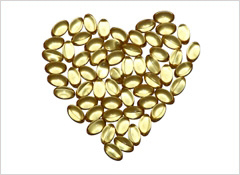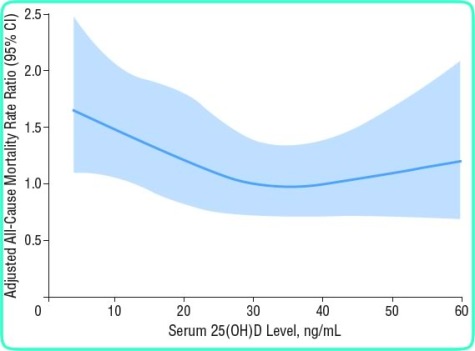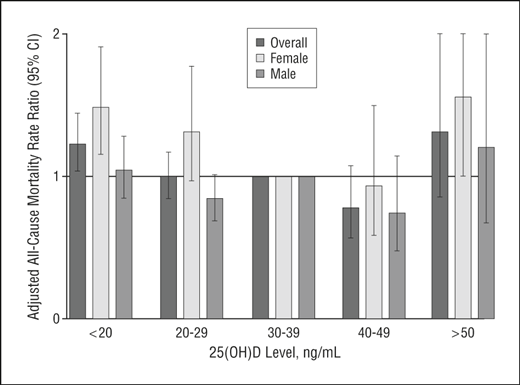Vitamin D connection to Artery Health
 Friday, October 14, 2011 at 11:18PM
Friday, October 14, 2011 at 11:18PM Vitamin D and Mortality chart below.
Not many scientists are connecting the dots on this one. There is an unfortunate mis-understanding about vitamin D and artery calcification that is being actively propagated by some Nutritionists. They are saying that taking higher amounts of vitamin D prevents heart disease. Here are some facts: 
- (Of interest) Vitamin D is involved with fighting infections and diseases of gum tissues -which are often linked with heart disease ref
- Artery calcification (calcium deposited in artery walls) is a risk factor for heart disease.
- Research shows that higher levels of Hormone vitamin D (1,25 OH2D3) are inversely related to artery calcification, meaning higher hormone D protects against calcification. ref
- Caution must be exercised here in that other compounding factors could play roles not yet understood. ref
- This hormone D form is not the same as the storage or supplemented D form (25-OHD3).
- Taking vitamin D supplements or getting sunshine vitamin D does NOT necessarily increase Hormone D levels. But it might under certain situations.
- Taking a large dose of calcium usually suppresses PTH (parathyroid hormone) closing down this trigger that the body uses to increase Hormone D production.
- IN FACT, Too much habitual calcium can turn OFF or limit the production of Hormone D and reduces further calcium absorption percentages.
- While higher intakes of calcium lower PTH levels, it also increases renin production, not good for one type of hypertensives, ref an apparent conflict from earlier calcium observations that showed a lowering of blood pressure.
- Taking higher amounts of vitamin D tends to increase calcium and phosphorous absorption, it's main function.
- A reduced calcium blood level is the trigger for producing Hormone D through PTH action.
- There are some conflicts among and between these statements that are confusing this issue.
- Vitamin K interacts with vitamin D in many ways. Vitamin D builds a protein called osteocalcin that when activated by vitamin K2, controls a number of important functions, including one connecting S protein and Covid-19. ref
- Here are the functions for osteocalcin when activated by vitamin K2. Activated osteocalcin binds calcium into bone. The ratio of activated to not-activated osteocalcin also helps regulate blood sugar levels, prevents atery calcification, and new, also protects brain cells against dementia. ref
Does it make sense to take excessive amount of calcium and/or vitamin D? Maybe there is a proper dosage range to stay within for supplements to optimize bone density and offer heart protection. Plus, variety of daily amounts may be one key. Too little, too much, or just right. Foods tend to buffer minerals and vitamins so they are not released all at once compared to the amounts and methods supplements release nutrients. One interesting fact is that higher hormone D levels are associated with less calcification in arteries. This is opposite of what was expected from hormone D functions since hormone D increases calcium absorption and releases calcium out of bones that goes into blood. Another function of hormone D must influence whether or not calcium goes into artery plaque. Check out vitamin K actions here.
Someone might increase calcium to combat blood pressure but put themselves into a higher risk category for prostate cancer. Vitamin D just might only be guilty of doing what it is designed to do, increase calcium absorption. Check out this artery vitamin D study showing best vitamin D levels in healthy people is between 30-37 ng/ml. ref Other studies before this have not shown this same effect, so needs more verification.
The following copy from this ref explains the case.
The actions of 1,25-vitamin D (hormone D) are directed toward maintaining serum calcium homeostasis28 through control of osteoblast (cells that build bone) function and osteoclast (cells that tear down bone) differentiation of monocytes. In addition, 1,25-vitamin D is the only known stimulator of intestinal calcium absorption, an effect thought to account for most of its value in the prevention of osteoporosis.
In vivo (inside body), 1,25-vitamin D may be either a potent stimulator of bone resorption (tearing down) or a potent stimulator of bone mineralization (building up), depending on the physiological state.29For example, in vitamin D–replete (lots of D) animals (based on levels of the storage form, 25-hydroxyvitamin D), active vitamin D stimulates bone resorption (tearing down), whereas in vitamin D–depleted (low D) animals, it stimulates bone mineralization (build up).
In addition, oral consumption of vitamin D does not directly relate to levels of 1,25-vitamin D because of the strict physiological regulation of the activating enzymes 25-hydroxylase and 1-α-hydroxylase.30 Thus, the finding of previous investigators that high doses of oral vitamin D3 induce severe vascular calcification in animals31 32 33 34 35 does not address the relationship of vascular calcification to serum levels of 1,25-vitamin D and is not inconsistent with our results. Indeed, it is reported that patients using continuous ambulatory peritoneal dialysis develop vascular calcification when treated with oral vitamin D3 but not when treated with 1,25-vitamin D.
ANALYSIS: In animals, Taking mega doses of supplemental vitamin D and calcium appear to increase the risk of artery calcification. And, it appears this also happens in people undergoing dialysis since diseased Kidneys do not make enough active hormone D. Discovering if this process is also a factor in healthy people should be a high priority, and it appears this action can be balanced and / or occurs at a much slower rate. People on dialysis have to be given the hormone form of vitamin D to prevent bone density problems, the supplement form 25-OHD3 does not have this protective action.
 The vitamin D story is one of great complexity. Many variables and players: the enzyme needed to turn 25 OHD into the hormone form of D, 1,25 OH2D3, the two forms of D, the hormone PTH from the parathyroid gland, another one from the thyroid gland, and the oral intake levels of minerals, calcium, phosphorous, magnesium, and potassium. Body balance points can vary widely between individuals due to compensatory actions. The D story is ever changing as new facts are discovered.
The vitamin D story is one of great complexity. Many variables and players: the enzyme needed to turn 25 OHD into the hormone form of D, 1,25 OH2D3, the two forms of D, the hormone PTH from the parathyroid gland, another one from the thyroid gland, and the oral intake levels of minerals, calcium, phosphorous, magnesium, and potassium. Body balance points can vary widely between individuals due to compensatory actions. The D story is ever changing as new facts are discovered.
The next copy summary from Circulation Journal in 1998, pretty much says it all with a new twist on hormone D actions:
"Because vitamin D and calcium supplementation are widely used for the treatment of osteoporosis, especially in the elderly,36 it is important to determine whether long-term supplementation of vitamin D for osteoporosis exacerbates vascular calcification. It is suggested from the present study that pharmacological doses of 1,25(OH)2D3 may stimulate vascular calcification through a direct action on VSMCs. However, high doses of oral vitamin D, which induces vascular calcification in experimental animals, do not always increase serum levels of 1,25(OH)2D, but 25OHD is increased,15,37,38 because the serum level of 1,25(OH)2D is strictly regulated within the narrow range by PTH, regardless of the nutritional status of vitamin D. The mechanism by which increased levels of serum 25OHD induce vascular calcification remains to be clarified. Local production of 1,25(OH)2D by 1-hydroxylase expressed in macrophages accumulated in atherosclerotic lesions may be involved in this process.39 Therefore, it is important to monitor serum levels of 25OHD during vitamin D supplementation. If serum levels of 25OHD are increased beyond the normal range, vascular calcification may develop even within normal levels of 1,25(OH)2D."
Or in simple language, taking mega vitamin D is like playing with fire. You might get burnt if blood levels go beyond the normal range. The body attempts to maintain balance by adaptations to absorption and elimination processes. Plus, the normal range is still somewhat under scientific debate.
Does supplemental vitamin D increase artery calcification? It may depend upon other conditions in the body (vitamin K levels, oxidation of LDL) plus vitamin D storage blood levels. Finding the correct answer should be priority one for scientific nutritional researchers. Watch for updates. And until then, precautionary principles are in play. ref
Scientists still have to account for the facts as presented on this vitamin D and mortality chart from the NHANES study.

And as represented here for Overall mortality at different 25-OHD levels

The above charts reveal an association rather than a cause and effect. Why is the mortality for Females higher for both under >20 and over <50?
SIDEBAR: Study showed Women who consume over 1400 mg of dietary calcium per day exhibit an increased risk of all-cause mortality versus Women who consume between 600-999 mg of dietary calcium. While this limited result study of 61,433 women followed for 19 years, it indicates calcium supplements might be more prudent for those who are low rather than for those already at a higher daily intake from diet. And that taking the full daily requirement from supplements, 1000mg to 1200mg, might not be wise since the diet on average supplies 648-768 mg. per day in US. This number includes average from supplements of 330mg. ref This means not everyone who supplements calcium is taking full 1000mg. Many multiple vitamins only have 100-200mg of calcium. The above study also found that 500 mg of supplemental calcium did not seem to influence results unless the dietary calcium intake was at or above 1400mg. Another study pointing to the amounts the new vitamin criteria developed on this website recommends for females, 400-600mg per day. DETERMINING DIETARY AMOUNTS IS NECESSARY.
PROTECTING BONES WITH ENOUGH CALCIUM AND VITAMIN D HAS TO BE BALANCED AGAINST OTHER FACTORS THAT MAY INFLUENCE HOW THE BODY UTILIZES THESE NUTRIENTS AND WHERE CALCIUM ENDS UP. IN BONES IS GOOD WHILE TOO MUCH IN SOFT TISSUES AND ARTERY WALLS IS NOT GOOD.